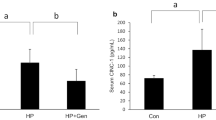Abstract
Objective
To observe the effect of volatile oil of amomum (VOA) on the expressions of mastocarcinoma-related peptide (PS2) and platelet activating factor (PAF) in helicobacter pyloriassociated gastritis (HPG) and to analyze its potential mechanism.
Methods
Eighty patients with HPG were randomly assigned to two groups, 42 patients in the treated group treated with 0.5 mL VOA, thrice per day; and the 38 patients in the control group receiving Western tertiary medicinal treatment. Gastroscopic picture and helicobacter pylori (HP) infection (by quick urease and Warthin-Starry stain) of the gastro-membrane, expressions of PS2 and PAF (by immunohistochemical assay and Western blotting) as well as the contents of aminohexose and phospholipid (by Neuhaus method) in the gastric membrane of all patients were detected before treatment and 4 weeks after treatment. The clinical effi cacy in the two groups was compared.
Results
The total effective rate in the treated group was 88.1%, which was significantly higher than that in the control group (78.9%, P<0.05). After treatment, in the treated group, gastric membranous contents of aminohexose and phospholipid was increased, expression of PS2 elevated but that of PAF lowered, all showing significant difference as compared with those in the control group (P<0.01). In the control group, the expressions of PS2 and PAF changed insignificantly. The radical eliminating rate of HP in the treated group and the control group was insignificantly different between them (76.1% vs. 65.8%, P>0.05).
Conclusion
The mechanism of VOA for anti-gastritis might be related with its action in increasing the expression of PS2 and decreasing the expression of PAF, and thus regulating the hydrophobicity of the gastric membrane.
Similar content being viewed by others
References
Tian DH, ed. Practical dictionary of material medica. 1st ed. Beijing: People’s Medical Publishing House, 2005:1369–1370.
Chinese Society of Digestive Diseases. Consensus Documents of Chronic Gastritis Symposium. Chin J Gastroenterol (Chin)2000;5(2):77–79.
Joseph Sambrook, David W. Russell. Manual of molecule colony. 2nd ed. Beijing: Science Press, 2002:1713–1726.
Neuhaus OW, Letzring M. Determination of hexosamines in conjunction with electrophoresis on starch. Anal Chem 1975;29:1230–1233.
Ministry of Health, P.R. China. Guiding principle of clinical research on new drugs of TCM. Vol. 2. Beijing: China Medic-Pharmaceutic Sciences and Technology Publishing House, 1995:114–115.
Liu HJ, Xu GM, Li ZS. Defensive effect of glycoprotein and phospholipids in gastric mucosa in rats. Chin J New Gastroenterol (Chin) 1997;5(7):427–428.
Sarosick J, Slomiany A, Takagi A, et al. Hydrogenion diffusion in dog gastric glycoprotein: Effect of associated lipids and covalently bound fatty acids. Biochem Biophys Res Commun 1994;118: 523.
Asante M, Ahmed H, Patel P, et al. Gastric mucosal hydrophobicity in duodenal ulceration: Role of Helicobacter pylori infection density and mucus gel. Gastroenterology 1997;113:449–454.
Wakabayshi H, Orihara T, Nakaya A, et al. Effect of Helicobacter pylori infection on gastric mucosal phospholipids contents and their fatty acid composition. J Gastroenterol Hepatol 1998;13: 566–571.
Lugea A, Antolin M, Mourelle M, et al. Deranged hydropholic barrier of the rat gastroduodenal mucosa after parenteral nonsteroidal anti-inflammatory drugs. Gastroenterology 1997;112:1931–1939.
Barnard JA, Beauchamp RD, Russell WE, et al. Epidermal growth factor-related peptides and their relevance to gastrointestinal pathophysiology. Gastroenterology 1995;108:564–580.
Lin SR. Enhancing the study of protective mechanisms of gastric mucosa. Chin J Gastroenterol (Chin) 1999;4(3):131–132.
LI ZS, Zhan XB, Xu GM, eds. Gastric lesion and protection—basis and clinics. Shanghai: Shanghai Scientific and Technical Publishers, 2004:107–111.
Author information
Authors and Affiliations
Corresponding author
Rights and permissions
About this article
Cite this article
Huang, Gd., Huang, Yh., Xiao, Mz. et al. Effect of volatile oil of amomum on expressions of platelet activating factor and mastocarcinoma-related peptide in the gastric membrane of chronic gastritis patients with helicobacter-pylori infection. Chin. J. Integr. Med. 14, 23–27 (2008). https://doi.org/10.1007/s11655-008-0023-6
Received:
Published:
Issue Date:
DOI: https://doi.org/10.1007/s11655-008-0023-6




